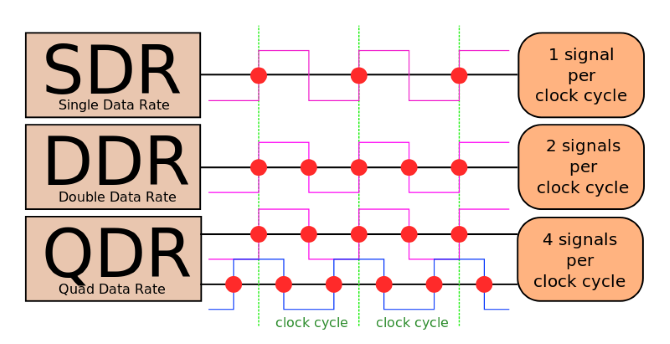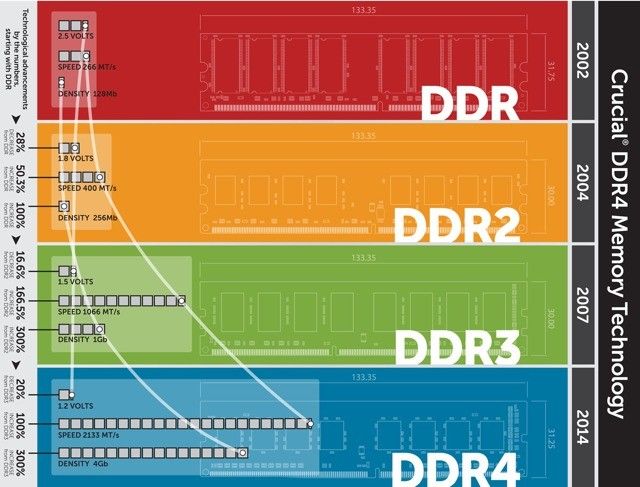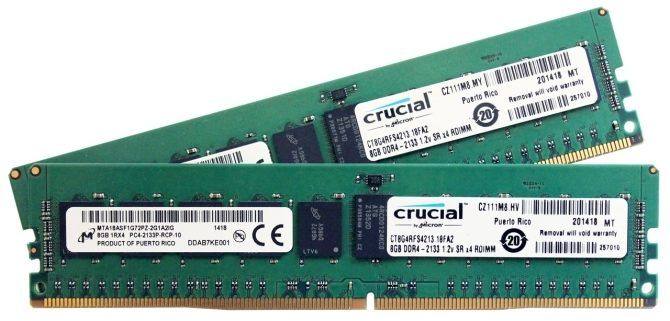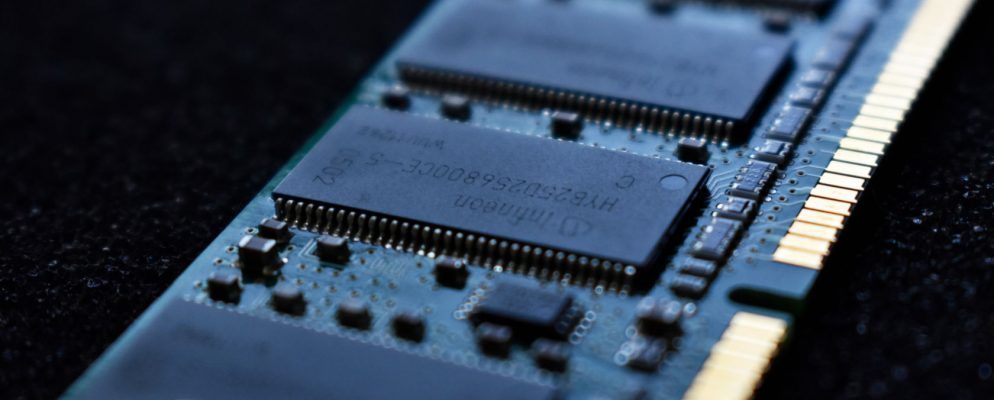RAM, which stands for Random Access Memory, is a short-term storage location your computer uses for running processes. You might not think much about RAM besides the amount of it when buying a new computer.
But not all RAM is created equal. Different generations of RAM provide different speeds and are only compatible with certain systems. Here are the differences between DDR2 and DDR3 RAM, compared to the newer DDR4 RAM.
What Is DDR RAM?
If you’re new to RAM, you might not know what “DDR” means. This abbreviation stands for double data rate.
In simple terms, operating at a double data rate means the RAM can transfer data two times per clock cycle. As you probably know, all data on a computer is digital, meaning it’s represented by a 1 (on) or a 0 (off).
One clock cycle is represented by the CPU signal going from off to on and back again. This is usually measured from the halfway point, as you can see in the chart below.

This double data rate is a major upgrade from old SDR (single data rate) RAM, which only operated once per clock cycle. Original DDR RAM first became generally available in 2000, and like SDR RAM, is now obsolete. Virtually all RAM you’ll find available now is some generation of DDR.
But why do these generations of RAM change?
DDR Generations Explained
Original DDR RAM was superseded by DDR2, DDR3, and now DDR4. These are all future generations of the same technology with faster speed and other improvements, and are all the same physical size.
This isn’t out of the ordinary, since many computing standards evolve over time. But you might wonder where DDR2 and DDR3 came from, and why they emerged.
The generation of RAM used with a computer is closely tied to the development of processors and motherboards. As companies like Intel come out with new CPU technology, they require new motherboard chipsets. This is a set of electronic components that let all the parts of a computer communicate properly.
New generations of RAM are necessary to work with the latest chipsets. This is why we’ve seen DDR2, DDR3, and DDR4 RAM after the original generation. Without these advancements, we wouldn’t be able to put RAM into newer systems.
Importantly, RAM is not backwards or forwards-compatible. If your motherboard is designed for DDR4 RAM, DDR3 RAM simply won’t work in it. It’s thus vital when building or upgrading a PC that you buy the right generation of RAM for compatibility.
Each generation of RAM has its notch in a slightly different position, so it’s impossible to put the wrong type in your computer.

DDR2 vs. DDR3 RAM

You might wonder how the newer generations of DDR RAM stack up. Let’s look at DDR2 and DDR3 RAM differences first. While you’re unlikely to find DDR2 RAM in many places today (it did become available back in 2004) it’s still useful for comparison.
While original-generation DDR RAM ran two data transfers per clock cycle, DDR2 RAM can produce four transfers per cycle instead. DDR3 takes this even further, as it can produce eight transfers for every clock cycle.
When it comes to speed, DDR3 is unsurprisingly faster. One way to measure RAM speed is megatransfers per second, or MT/s. This refers to the number of operations the RAM can complete every second; 1MT/s is one million transfers per second.
While DDR2 RAM has data transfer rates ranging from 400 to 1,066MT/s, DDR3 smashes this at 800-2,133MT/s.
Voltage is another important aspect of RAM generations. DDR2 RAM uses 1.8V, while DDR3 is lower at 1.5V. Lower voltage means the RAM uses less power, thus putting less strain on the CPU.
You can find sticks of DDR2 RAM that are 4GB, but the most common maximum is 2GB. Practically, DDR3 RAM caps out at 8GB per stick, though some 16GB sticks are available.
DDR3 vs. DDR4 RAM
Continuing with our discussion of RAM differences, how does DDR4 RAM stack up? DDR3 was introduced in 2007 and while it’s still used with some older systems today, DDR4 has become the standard.
DDR4 runs at an even lower voltage than DDR3, at just 1.2V. It’s also capable of more operations per second, ranging from 1,600MT/s to 3,200MT/s.
Samsung sells a single 32GB stick of DDR4 RAM, but it’s quite expensive. The maximum you’ll see in the wild is usually 16GB.
If you’re in the market, we have a buying guide covering the best DDR4 RAM
The Best DDR4 RAM to Improve Your PC’s Performance
The Best DDR4 RAM to Improve Your PC’s Performance
If your computer is feeling sluggish or slow, then you may be due a RAM upgrade. Here’s the best DDR4 RAM for your next upgrade.
Read More
.
Coming Soon: DDR5 RAM
At the time of writing, DDR4 RAM is the standard. But DDR5 is on the horizon, expected to launch sometime in 2020.
It will probably be a few years before DDR5 becomes standard, so you’re fine to build a computer with DDR4 RAM now.
How RAM Differences Affect You
We’ve thrown around a lot of values above, but don’t feel overwhelmed. The average user shouldn’t ever have to worry about which generation of RAM to buy. You can simply let the motherboard/processor you want to purchase dictate what RAM to get. When building a computer today, you’ll almost certainly have a setup that uses DDR4 RAM.
You might wonder how the different RAM generations affect performance. For the average user, it really won’t make much of a difference. DDR4 is theoretically faster than DDR3, but it’s not often that RAM speed is the bottleneck on your system.
In most cases, other upgrades will improve your computer’s performance more
These Upgrades Will Improve Your PC Performance the Most!
These Upgrades Will Improve Your PC Performance the Most!
Need a faster computer but aren’t sure what you should upgrade on your PC? Follow our PC upgrade checker to find out.
Read More
. Swapping an old HDD for an SSD, adding more overall RAM, or upgrading your processor will have a much greater effect than slightly faster RAM.
The main scenario where the intricacies of RAM really matter is in heavy use, such as in servers. These machines run heavy loads constantly, meaning that every bit of performance is vital. In normal use, you’d be hard-pressed to feel a difference between two systems with identical stats except for the generation of RAM.
Other Important Aspects of RAM
If you buy a prebuilt computer off the shelf, everything is already assembled, so there’s no worry. But if you’re building your own PC, you should be aware of other RAM values aside from the generation that we’ve focused on here.
Have a look at our general guide to RAM
A Quick and Dirty Guide to RAM: What You Need to Know
A Quick and Dirty Guide to RAM: What You Need to Know
RAM is a crucial component of every computer, but it can be confusing. We break it down in easy-to-grasp terms you’ll understand.
Read More
, which goes into more detail on other specifications.
DDR vs. DDR2 vs. DDR3 vs. DDR4: Cleared Up
Now you know the basic differences between DDR2 and DDR3, plus what DDR4 brings to the table.
In essence, DDR2, DDR3, and the rest are incremental improvements on the same technology. Aside from making sure you purchase RAM that’s compatible with your system (ideally the newest generation), you don’t need to worry much about it. But it’s useful to know what all those numbers and letters mean for RAM.
If you’re a PC gamer, dive deeper into this topic with our guide to RAM for gaming
What Does RAM Do for Gaming and How Much RAM Do I Need?
What Does RAM Do for Gaming and How Much RAM Do I Need?
Wondering how RAM affects your gaming PC and what kind of RAM you should buy? Here’s an explanation of RAM for gamers.
Read More
.
Explore more about: Computer Memory, Hardware Tips, .
